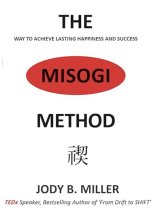The MISOGI Method
Centuries ago, a Japanese Shintō ritual was taking shape. A ritual that promised to purify the soul, to eliminate impurities, to renew, to be reborn. The problem is, the MISOGI ritual was more of a shock to the system because you had to stand practically naked, under a freezing waterfall in order to get the full effect. I don’t know if this ritual started because the Shintō practice endorsed pain and suffering. I have found no research to that effect. But what I did find was the story behind the story, all of which played a part in the unfolding of my story to landing a TEDx talk and developing the current MISOGI Method. A way to achieve lasting happiness that will help you realize the unlimited possibilities in your life.
PART ONE WHAT IS A MISOGI AND WHERE DOES IT COME FROM? CHAPTER ONE TRADITIONS & RITUALS “We all need such places of ritual safekeeping. And I do believe that if your culture or tradition doesn’t have the specific ritual you are craving, then you are absolutely permitted to make up a ceremony of your own …” — Elizabeth Gilbert, Eat, Pray, Love. CENTURIES AGO, a Japanese Shintō ritual was taking shape. A ritual that promised to purify the soul, to eliminate impurities, to renew, to be reborn. But before we jump into this amazing ritual and the positive, lasting effects if can have for you, it’s important to understand what rituals are—and what they aren’t. Where they came from and how they differ from tradition. By having a clear understanding of ritual, you will be better prepared not only for this ancient ritual (if you are brave enough to perform it), but for your modern-day MISOGI journey. WHAT A RITUAL IS NOT A ritual is not a tradition. A tradition is closer to a belief that has been handed down over years or centuries by a group, sect or entire society. A tradition has deep personal meaning that seeks to preserve the past in the present and keep it alive for the future. There are usually symbols associated with traditions. Examples of traditions include holidays such as … • Christmas (Christian based), which always falls on December 25th and which celebrates the birth of Jesus. Gifts are often exchanged. Most homes host a large tree that they decorate with lights and ornaments. Families and friends gather to celebrate with traditional food, stories and conversation. • Hanukkah (Judaism based) is celebrated over 8 days in December. The holiday celebrates the rededication of the Second Temple of Jerusalem. Candles are lit on each day of Hanukkah and gifts are often given each day. • St. Lucia’s Day (Swedish based) is celebrated on December 13th. St. Lucia’s Day honors an early Christian martyr, St. Lucia (or St. Lucy). Young girls wearing white and wreaths with candles on their heads are part of an annual festival in most towns. Particular Swedish delicacies are served to family and friends on this day. • Easter (Christian and/or bunny lover based) celebrates Christ rising on the third day after being crucified. • The Giant Lantern Festival in the Philippines is always on the Saturday before Christmas Eve. On this traditional day, everyone competes to create the most decorative lantern possible. • Eid al-Fitr (Muslim) in the beginning of June, is a celebration of the end of Ramadan, a month devoted to self-reflection, charity, fasting and prayer. During Eid al-Fitr, a congregation performs a particular set of prayers and offerings. I hope you’re getting the idea. Very special beliefs, ceremonies, celebrations and practices that evolve over hundreds, if not thousands of years. It’s a handing over of the past in order to keep it alive in the present and continued in the future. Then there are traditions that are simply fun, beautiful, peaceful, or a little whacky. Such as … • Śmigus-dyngus (or wet Monday) in Poland. It’s a fun way to celebrate Easter by blasting one another with water. • In Bali, New Year’s is celebrated by Nyepi; 24 hours of meditation, silence and reflection. The day after is filled with friends, family, food and celebration. • In the Alps, finger wrestling (or pulling) has become a tradition over the years. It was once used to settle disagreements but has evolved into a fun tradition. Ouch! • Yee Peng (Lantern Festival) in Chiang Mai is one of my personal favorites. It is celebrated on the full moon of the 12th lunar month of each year (usually mid-November). The tradition of letting go of lit paper lanterns is meant to symbolize letting go of sadness and misfortunes from the previous year and making a happy wish for the new year. SS Licensed Photo I could go on … But I think you get the idea. As part of your MISOGI journey, understanding your personal traditions and rituals will be part of the process to discovering your MISOGI that can transform your life for the better and for the long-term. WHY WRITE IT DOWN? The simple act of writing (by hand) enables you to retain information more completely. I was looking at my high school yearbook recently and just by the way my friends handwriting spilled over a page, I literally remembers specific events, experiences and moments of laughter that I had filed away somewhere deep on my brain. This ability to recall by just looking at the way someone writes made me curious. I found the book of quotes and poems that I had started in fourth grade and started to read it. On the inside cover was a list of every address I had lived at since age 5. I added my newest address to the list. It was such fun to see my handwriting at different ages. It’s still a little messy, but I can see when I changed from cursive to print. That was during my body changing years. I thought it was cool to print instead of writing in script. I read the quotes I had collected because they inspired me. Wow. I still love those quotes to this day. I have used them in my adult writing without even realizing it. I read on. Some of the poems I scribbled (yes, sometimes my handwriting looks like scribble) came from heartbreak, and some of the songs from an outpouring of love or infatuation. My entire emotional life was recorded in my book. All at my own hand. Writing by hand can enhance your intelligence, improve your writing skills and help you to focus. As we age, we tend to forget things. I left my cool Thailand water bottle at my loft workspace yesterday. Why? I was in a hurry to get to my exercise class. So if you find yourself getting forgetful about what you were going to get at the grocery store or where you left your keys, write it down. Journaling or taking notes by hand can increase your creativity. You may start to write faster as you enter your creative stride, or your handwriting may change. It’s a mirror to what’s going on with you at that moment. Writing things down by hand gives your mind space to interpret, consider and absorb. And when you get all those thoughts and lists in your head on paper, you experience relief because you know you’ll remember. Writing by hand may even enhance your IQ. You can write in bullets, choppy sentences or long, winding verbiage. It doesn’t matter. Just write it down. I keep a notebook and pen by my bed. Often, in the middle of the night, I get great ideas, revelations or words that I want to use in the book I am writing (or a future book). I am always writing stuff down. It helps me feel organized, is an outlet to express myself and a motivator. If you are going through an emotional time, write it down. If you are facing a relationship, work or physical challenge, write it down. If you want to get clear, know yourself and transform…you know what to do. As you go through this book, I ask you to write it down. At the end of every chapter there is a place to do this. If you are reading the digital version of this book, print out the pages and keep them all in a file for later reflection and proof of progress.
Translation
Translate and read this book in other languages:
Select another language:
- - Select -
- 简体中文 (Chinese - Simplified)
- 繁體中文 (Chinese - Traditional)
- Español (Spanish)
- Esperanto (Esperanto)
- 日本語 (Japanese)
- Português (Portuguese)
- Deutsch (German)
- العربية (Arabic)
- Français (French)
- Русский (Russian)
- ಕನ್ನಡ (Kannada)
- 한국어 (Korean)
- עברית (Hebrew)
- Gaeilge (Irish)
- Українська (Ukrainian)
- اردو (Urdu)
- Magyar (Hungarian)
- मानक हिन्दी (Hindi)
- Indonesia (Indonesian)
- Italiano (Italian)
- தமிழ் (Tamil)
- Türkçe (Turkish)
- తెలుగు (Telugu)
- ภาษาไทย (Thai)
- Tiếng Việt (Vietnamese)
- Čeština (Czech)
- Polski (Polish)
- Bahasa Indonesia (Indonesian)
- Românește (Romanian)
- Nederlands (Dutch)
- Ελληνικά (Greek)
- Latinum (Latin)
- Svenska (Swedish)
- Dansk (Danish)
- Suomi (Finnish)
- فارسی (Persian)
- ייִדיש (Yiddish)
- հայերեն (Armenian)
- Norsk (Norwegian)
- English (English)
Citation
Use the citation below to add this book to your bibliography:
Style:MLAChicagoAPA
"The MISOGI Method Books." Literature.com. STANDS4 LLC, 2025. Web. 9 Mar. 2025. <https://www.literature.com/book/the_misogi_method_3440>.








Discuss this The MISOGI Method book with the community:
Report Comment
We're doing our best to make sure our content is useful, accurate and safe.
If by any chance you spot an inappropriate comment while navigating through our website please use this form to let us know, and we'll take care of it shortly.
Attachment
You need to be logged in to favorite.
Log In